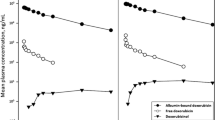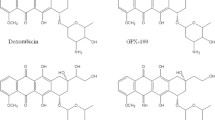Abstract
A high-pressure liquid chromatographic method for determination of the bisdioxopiperazine derivative ADR-529 (ICRF-187), a compound proven effective in protection against anthracycline-induced cardiotoxicity, has been developed. The limit of quantitation was 5 ng/ml using a narrow-bore 5-μm silica column and UV detection. The method was used for determination of pharmacokinetic profiles of ADR-529 after a 3-weekly i.v. administration of different doses of ADR-529 (600–1000 mg/m2) together with different doses of epirubicin (E, 60–100 mg/m2), fixed-dose cyclophosphamide (C, 600 mg/m2), fixed-dose 5-fluorouracil (F, 600 mg/m2), and daily administration of tamoxifen (T, 30 mg; CEF-T) in the treatment of patients with metastatic breast cancer. Pharmacokinetic parameters for epirubicin were also determined. The aim of the study was to determine (1) whether the pharmacokinetics of ADR-529 as part of a combination with CEF-T changes with increasing doses of ADR-529 and increasing doses of epirubicin and (2) whether the pharmacokinetics of epirubicin in the same combinations is altered with the administration of increasing doses of ADR-529. A total of 82 patients were included. A crossover study including 16 of the patients showed no significant difference in epirubicin pharmacokinetic parameters when epirubicin was given with or without concomitant administration of ADR-529. Apart from minor changes in the distributional half-lives, the pharmacokinetic parameters of epirubicin were not altered with increasing doses of ADR-529, nor were the pharmacokinetic parameters of ADR-529 itself. Escalating doses of epirubicin did not significantly alter the pharmacokinetic parameters of ADR-529 with the exception of a 30% increase in the terminal half-life and a decrease in total body clearance when the epirubicin dose was raised from 60 to 100 mg/m2. We conclude that concomitant administration of ADR-529 does not alter the distribution and elimination of epirubicin in doses suitable for preventing the anthracycline-induced cardiotoxicity.
Similar content being viewed by others
References
Agen C, Bernardini N, Danesi R, Torre PD, Costa M, Del Tacca M (1992) Reducing doxorubicin cardiotoxicity in the rat using deferred treatment with ADR-529. Cancer Chemother Pharmacol 30: 95
Ambrosini G, Balli M, Garusi G, et al, for the Italian Multicentre Breast Study With Epirubicin (1988) Phase III randomized study of fluorouracil, epirubicin, and cyclophosphamide v fluorouracil, doxorubicin, and cyclophosphamide in advanced breast cancer: an Italian multicentre trial. J Clin Oncol 6: 976
Camaggi CM, Comparsi R, Strocchi E, Testoni F, Angelelli B, Pannuti F (1988) Epirubicin and doxorubicin comparative metabolism and pharmacokinetics: a crossover study. Cancer Chemother Pharmacol 21: 221
Cersosimo RJ, Hong WK (1986) Epirubicin: a review of the pharmacology, clinical activity and adverse effects of an adriamycin analogue. J Clin Oncol 4: 425
Creighton AM, Hellmann H, Whitecross S (1969) Antitumor activity in a series of bisdiketopiperazines. Nature 222: 384
Eksborg S, Stendahl U, Lönroth U (1986) Comparative pharmacokinetic study of adriamycin and 4′ epi-adriamycin after their simultaneous intravenous administration. Eur J Clin Pharmacol 30: 629
Herman EH, Ferrans VJ (1983) Ifluence of vitamin E and ICRF-187 on chronic doxorubicin cardiotoxicity in miniature swine. Lab Invest 49: 69
Herman EH, Ferrans VJ, Jordan W, Ardalan B (1981) Reduction of chronic daunorubicin cardiotoxicity by ICRF-187 in rabbits. Rec Commun Chem Pathol Pharmacol 31: 85
Herman EH, Ferrans VJ, Myers CE, Vleet JF van (1985) Comparison of the effectiveness of (+/-)-1,2-bis(3,5-dioxopiperazinyl-1-yl)-propane (ICRF-187) andN-acetylcysteine in preventing chronic doxorubicin cardiotoxicity in beagles. Cancer Res 45: 276
Herman EH, El-Hage A, Ferrans VJ (1988) Protective effect of ICRF-189 on doxorubicin-induced cardiac and renal toxicity in spontaneously hypertensive and normotensive rats. Toxicol Appl Pharmacol 92: 42
Hochster H, Liebes L, Wadler S, Oratz R, Wernz JC, Myers M, Green M, Blum RH, Speyer JL (1992) Pharmacokinetics of the cardioprotector ADR-529 (ICRF-187) in escalating doses combined with fixed-dose doxorubicin. J Natl Cancer Inst 84: 1725
Hochster H, Narang PK, Lewis RC, Baldwin J, Khojestah A, Reynolds, RD, Speyer J, Gams R (1992) Pharmacokinetics of cardioprotectant dexrazoxane (DZR) in advanced cancer patients. Proc Am Soc Clin Oncol 11: 323
Hurteloup P, et al, for the French Epirubicin Study Group (1988) A prospective randomized phase III trial comparing combination chemotherapy with cyclophosphamide, fluorouracil, and either doxorubicin or epirubicin. J Clin Oncol 6: 679
Jakobsen P, Steiness E, Bastholt L, Dalmark M, Lorenzen A, Petersen D, Gjedde SB, Sandberg E, Rose C, Nielsen OS, Mouridsen HT, Jakobsen A (1991) Multiple-dose pharmacokinetics of epirubicin at four different dose levels: studies in patients with metastatic breast cancer. Cancer Chemother Pharmacol 28: 63
Lewis RC, Phillips BA, Baldwin JR, et al (1992) A sensitive and specific procedure for quantitation of ADR-529 in biological fluids by high-performance liquid chromatography (HPLC) with column switching and amperometric detection. Pharm Res 9: 101
Martoni A, DiMarco AR, Camaggi CM, et al (1983) Doxorubicin and 4-epi-doxorubicin: clinical experience and pharmacokinetics. Drugs Exp Clin Res 1983: 767
Milliard JA, Speyer JL, Hanson K, Shaikh BS, Chang A, Ryan K (1992) Prevention of chronic adriamycin cardiotoxicity with the bisdioxopiperazine dexrazoxane (ICRF-187, ADR-529, Zinecard) in patients with advanced or metastatic breast cancer. Proc Am Soc Clin Oncol 11: 91
Mross K, Maessen P, Vijgh WJF van der Gall H, Boven E, Pinedo HM (1988) Pharmacokinetics and metabolism of epidoxorubicin and doxorubicin in humans. J Clin Oncol 6: 517
Narang PK, Hochster H, Reynolds, RD, Rossi D, Lewis R, Colborn D, Baldwin J, Khojestan A, Speyer J, Bianchine JR (1992) Does the cardioprotectant dexrazoxane (DZR) affect doxorubicin (DOX) kinetics/dynamics? Proc Am Soc Clin Oncol 11: 324
Neri B, Cini-Neri G, Bandinelli M, Pacini, Bartalucci S, Ciapini A (1989) Doxorubicin and epirubicin cardiotoxicity: experimental and clinical aspects. Int J Clin Pharmacol Ther Toxicol 27: 217
Perkins WE, Schroeder RL, Carrano RA, Imondi AR (1982) Effect of ICRF-187 on doxorubicin-induced myocardial effects in the mouse and guinea pig. Br J Cancer 46: 662
Robert J, Vrignaud P, Nguyen-Ngoc T, Iliadis A, Mauriac L, Hurteloup P (1985) Comparative pharmacokinetics and metabolism of doxorubicin and epirubicin in patients with metastatic breast cancer. Cancer Treat Rep 69: 633
Rosenfeld CS, Weisberg SR, York RM, Jones SE, Spicer DV, Khojasteh A (1992) Prevention of adriamycin cardiomyopathy with dexrazoxane (ADR-529, ICRF-187). Proc Am Soc Clin Oncol 11: 62
Speyer JL, Green MD, Kramer E, et al (1988) Protective effect of the bispiperazinedione ICRF-187 against doxorubicin-induced cardiac toxicity in women with advanced breast cancer. N Engl J Med 319: 745
Speyer JL, Green MD, Zeleniuch-Jacquotte A, Wernz JC, Rey M, Sanger J, Kramer E, Ferrans V, Hochster H, Meyers M, Blum RH, Feit F, Attubato M, Burrows W, Muggia FM (1992) ICRF-187 permits longer treatment with doxorubicin in women with breast cancer. J Clin Oncol 10: 117
Verhoef V, Bell V, Filppi J (1988) Effect of the cardioprotective agent ADR-529 (ICRF-187) on the antitumour activity of doxorubicin. Proc Am Soc Clin Oncol 29: 273
Weisberg SR, Rosenfeld CS, York RM, Jones SE, Spicer DV, Khojasteh A (1992) Dexrazoxane (ADR-529, ICRF-187, Zinecard) protects against doxorubicin induced chronic cardiotoxicity. Proc Am Soc Clin Oncol 11: 91
Yamaoka K, Nakagawa T, Uno T (1978) Application of Akaike's information criterion (AIC) in the evaluation of linear pharmacokinetic equations. J Pharmacokinet Biopharm 4: 395
Author information
Authors and Affiliations
Rights and permissions
About this article
Cite this article
Jakobsen, P., Søresen, B., Bastholt, L. et al. The pharmacokinetics of high-dose epirubicin and of the cardioprotector ADR-529 given together with cyclophosphamide, 5-fluorouracil, and tamoxifen in metastatic breast-cancer patients. Cancer Chemother. Pharmacol. 35, 45–52 (1994). https://doi.org/10.1007/BF00686283
Received:
Accepted:
Issue Date:
DOI: https://doi.org/10.1007/BF00686283




